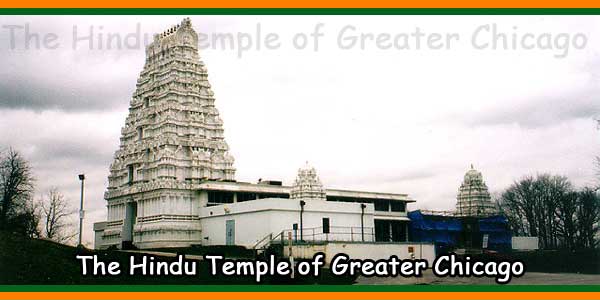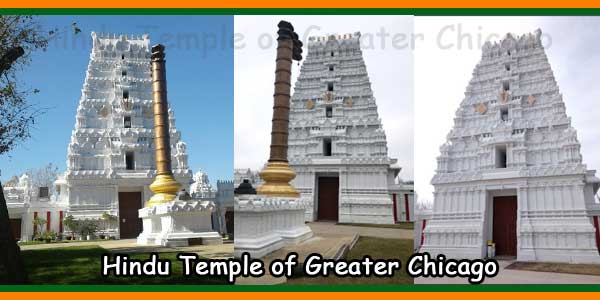Hindu Temple of Greater Chicago Hours:
9:00 AM to 8:45 PM All Days.
Hindu Temple of Greater Chicago Introduction:
The Hindu Temple of Greater Chicago (HTGC) is the culmination of deeply felt spiritual aspirations of the Hindus in the Greater Chicago area. The HTGC is a notfor-profit organization founded in 1977. It became a fullfledged functional house of worship in 1986. Besides providing a congenial atmosphere for spiritual advancement, it also serves as a focal point for celebrating the cultural diversity of the Hindus. Daily worships (pooja), grand festivals, exquisite cultural programs,
children’s education programs, energetic youth activities, and humanitarian projects radiate the power (shakti) of this spiritual sanctuary.

Hindu Temple of Greater Chicago Architecture:
Perched on a wooded hillside above the Des Plaines River valley in Lemont, Illinois, the temple represents one of the most impressive feats of devotion outside India. The temple complex consists of three buildings, the Rama temple, Ganesha-Shiva-Durga temple and a community center connecting the two temples. A fourth building (A Meditation center) is also being built and should be completed in the year 2010.
The Rama temple is built to specifications in the authentic style of the Chola dynasty (a 10th century dynasty of Indian Kings). The temple’s architecture is a perfect blend of the ancient with the modern. Its magnificent 80-foot tower (Gopuram) is a potent symbol of Hindu spirit. A large hall in the lower level of the temple has facilities to stage cultural events.
A smaller temple north of the Rama temple is the Ganesha-Shiva-Durga temple. This temple is built in the architecture style of the Kalinga dynasty (1st century B.C.E.).
Hinduism:
Hinduism is one of the oldest religions in the world. It is also known as Sanatana Dharma (eternal righteousness). Predating recorded history, it originated among the sages of ancient India around 6000 B.C.E.
Hindus believe that no particular religion teaches the only way to salvation, but that all genuine religious paths are part of God’s love, deserving tolerance and understanding. Nowhere else does the idea of unity of religions in its multiplicity find a more eloquent expression than in the following excerpt from the Rig Veda: “Ekam sat vipra bahudha vadanthi” which means “Truth is one; the wise call it by different names.” – The Rig Veda-verse 1.164.46. Hindus believe in the Supreme Reality (Parabrahman) and its trinity form of Brahma, Vishnu, and Shiva, the three aspects of Godhead. Brahma is the creator of the universe, Vishnu, the preserver, and Shiva, the redeemer. Vishnu appears in various incarnations (Avataras) to preserve the good and destroy the evil. One such popular incarnation is Lord Rama, the presiding deity of the temple.
Hindu philosophy states that the soul (Atman) can attain salvation (Moksha) through devotion to God (Bhakti) and doing one’s duty without attachment to the fruits of the actions. Hindus believe in the law of cause and effect by which each person creates his or her own destiny through thoughts, words, and deeds (Karma). The soul reincarnates, evolving through many births into different physical forms until it attains salvation (Moksha).
Hindu Temple of Greater Chicago Scriptures:
Hinduism cherishes one of the largest and oldest storehouses of scripture and philosophy on the earth. The major scriptures include the Vedas, the Upanishads, the Ramayana and the Bhagavad Gita. These texts offer guidance to the world’s more than 800 million Hindus for pursuing the path of righteousness and achieving spiritual growth.

Hindu Temple of Greater Chicago Rituals:
Over centuries, the day to day practice of Hindu religion has developed into symbolic rituals. Ritualistic prayers (Pooja and Archana) begin with the praise of the deities and end with a ceremonial conclusion (Aarti). Devotees are then offered holy water (Charanamrit) and blessed sweets (Prasad). Elaborate rituals form a significant part of many festivals.
Hindu Temple of Greater Chicago Idol Worship:
The purpose of idols in the temple and its serene atmosphere is to aid in one’s spiritual development by creating an environment congenial to turning thoughts away from worldly matters and focusing the mind on God. With the mind thus shifted away from the cares of the world, one is better prepared to approach the altar to worship.
Hinduism preaches that the God is formless and shapeless. The idols in a Hindu temple are symbolic. They help a person in many different ways in the process of spiritual awakening. When one is worshipping an idol, he or she is not really worshipping the physical form of the idol, but the spiritual quality of the divine symbolized by the idol. Rituals and ceremonies are intended to serve as channels for one’s devotion to God and to foster spiritualism. The ultimate aim of spiritualism is self-realization or union with God.
Hindu Temple of Greater Chicago Major Festivals:
Many festivals are celebrated at the temple through-out the year. Some of the major festivals celebrated are:
Sri Ramanavami occurs in April and celebrates the birthday of Sri Rama and his marriage to Sita Devi which was also took place on his birthday. Rama the seventh incarnation of Sri Vishnu, was born on the ninth (navami) day of Chaitra (March-April) maasa (month).
Shiva Ratri is celebrated on Krishna Chaturdashi day (14th day of a Lunar Month) in the month of Magha
(Feb-March) to commemorate the day on which Shiva protected the world from total annihilation by drinking the Kalakanda poison which was held in his throat (Neelakanta).
Janmastami celebrated the birthday of Sri Krishna, the eighth incarnation of Sri Vishnu. Rasa Lila is
performed to recreate incidents from the life of Krishna and to commemorate his love for Radha. The image of Krishna is bathed at midnight, placed in a cradle and worshiped. Janmastami occurs during the August September months.
Deepavali or Diwali is a festival celebrated throughout India with different regional significance. Deepavali is known as the festival of lights. Deepavali celebrates the homecoming of Rama after defeating Ravana.
Dussera or Dasara festival lasts for ten days. During this festival, Ram Lela or the story of Sri Rama are
enacted with the burning of the effigy of Ravana. it is also known as Navarathri and is celebrated nine days. it is customary to arrange various dolls on stepped platforms. The tenth day is known as Vijaya Dasami. Other major festivals celebrated at the temple include (but not limited to) Ganesha Chaturthi, Holi, Makara Sankranthi and New Year’s Day.
Sri Rama:
Lord Rama is one incarnation of Lord Vishnu (the preserver). His story is described in the epic Ramayana. The Ramayana teaches us how an ideal king, father, mother, husband, wife, brother, child, and friend should be. In the temple Lord Rama
(center) is with His wife Sita (right) and His brother Lakshmana. Born a prince, He spent 14 years in the forests fighting and defeating the forces of demons. Sita and Lakshmana voluntarily accompanied Lord Rama in the forests.
Sri Krishna and Sri Radha:
Lord Krishna, like Lord Rama, is one incarnation of Lord Vishnu. He is accompanied by Radha. The teachings of Lord Krishna are conveyed in the Bhagavad Gita in which he explains various paths of attaining salvation (Moksha). The Gita contains the essence of the Hindu scriptures. In it, the Lord proclaims, “To protect the pious, to annihilate the miscreants, and to establish righteousness, I advent myself millennium after millennium.”
Sri Venkateshwara Swami:
Lord Venkateshwara, also known as Lord Balaji, is another form of Lord Vishnu, the preserver of the universe. Bhoodevi and Shri Devi are his two consorts. Bhoodevi represents Mother Earth and Shri Devi is the Goddess of beauty.
Sri Anjaneya Swamy / Hanuman:
Anjaneya, also known as Hanuman, is the most ardent devotee of Lord Rama. He personifies the ultimate in obedience and devotion to the Supreme. In spiritual terms, His life, as described in the epic Ramayana, demonstrates that one can attain
salvation by devotion (bhakti). Although Hanuman has bodily features of a monkey, He still attained salvation. This shows that the bodily form is of no consequence in achieving salvation if one is dedicated to the Lord.
Sri Maha Lakshmi:
Goddess Maha Lakshmi is the consort of Lord Vishnu. She is worshipped as one who bestows prosperity. She is often depicted as seated on a lotus flower. Just as the unclean water beneath it does not defile the lotus flower’s beauty, so is the goddess’ beauty not defiled by anything impure.
Sri Ganesha:
In Hindu mythology, Lord Ganesha is the son of Lord Shiva and Goddess Parvati. He protects the living creatures from all
obstacles. Because of a boon bestowed on Him, all Hindu ceremonies begin with invocation to Lord Ganesha.
Lord Shiva:
The Shivalingam symbolizes Lord Shiva. Shiva is the redeemer in Hinduism’s holy trinity that includes Brahma, and Vishnu. Shiva dissolves the old and prepares one for reincarnation in the perpetual cycle of life and death.
Sri Durga Mata:
Goddess Durga protects the good from the evil. Durga, the goddess of shakti (energy), is also worshipped as Mata (Mother), Amba, and Kali. The four day long Durga Puja is the biggest annual festival in Bengal and few other states in India.
Sri Parvathi Devi:
Beautiful and virtuous, Goddess Parvati is Lord Shiva’s consort. She is the peaceful form of shakti (energy) in the universe and is worshipped as the universal Mother. The Gauri Festival is celebrated on the seventh, eighth, ninth of Bhadrapada Shukla. She is worshipped as the goddess of harvest and protectress of women. Her festival, chiefly observed by women, is
closely associated with the festival of her son Ganesha (Ganesh Chaturthi). Sri Subramanya Swami Sri Subramanya Swami
Subramanya Swami (also known as Kartikeya or Kumaraswamy) was born by the divine spark from Lord Shiva. Celestial women (Krithikas) raised him and therefore the name Kartikeya. He is worshipped for prosperity and for protection from evil.
Navagrahas:
Hindu astrology is based on nine celestial bodies, the Navagrahas. The Navagrahas are Surya (Sun), Chandra (Moon), Angaraka (Mars), Budha (Mercury), Brihaspati (Jupiter), Shukra (Venus), Sanaischaran (Saturn), Rahu and Ketu. The positions of these nine grahas at the time of birth are used to predict their astrological influences on an individual’s life.
Sri Vivekananda Statue:
A Statue of Swami Vivekananda graces a hillock to the east of the drive leading to the temple. This statue was installed in 1998. The bronze statue in a standing pose is 10-foot in height and has been modeled after his photograph taken in Chicago after his appearance at the World’s Parliament of Religions in 1893. It is the first statue of Swamiji to be installed in a public place in United States of America.
Vivekananda Center:
In continuation of the temple’s commitment to serve needs of its devotees and patrons in the TriState areas, a unique Meditation Center is being built near the Vivekanada Mantapa (Estimated completion date: 2010).
Hindu Temple of Chicago Address:
10915 Lemont Road,
Lemont,
IL 60439, USA
Phone: +1 630-972-0300
